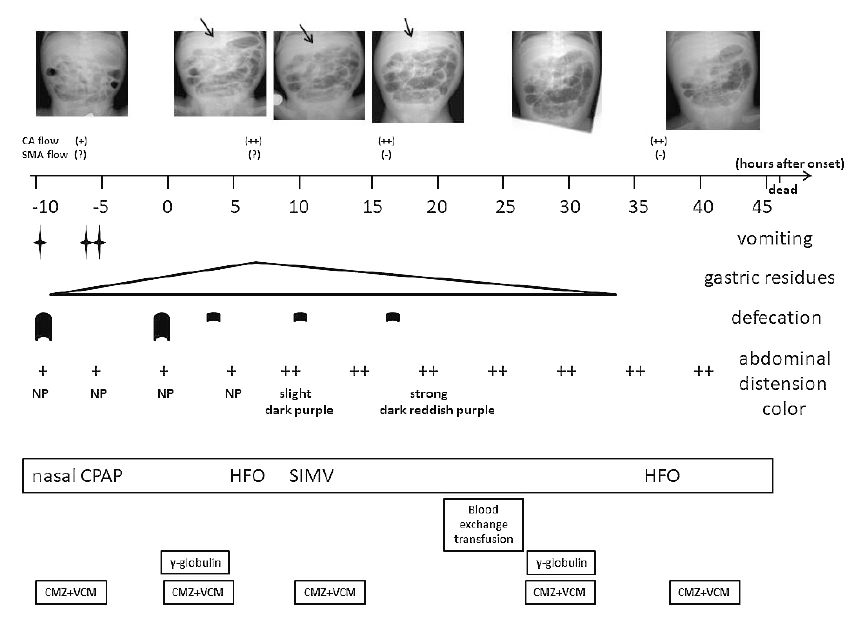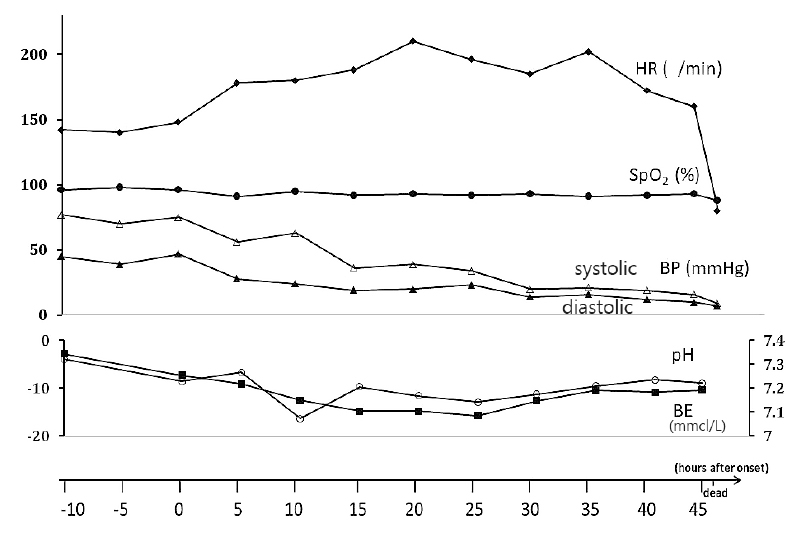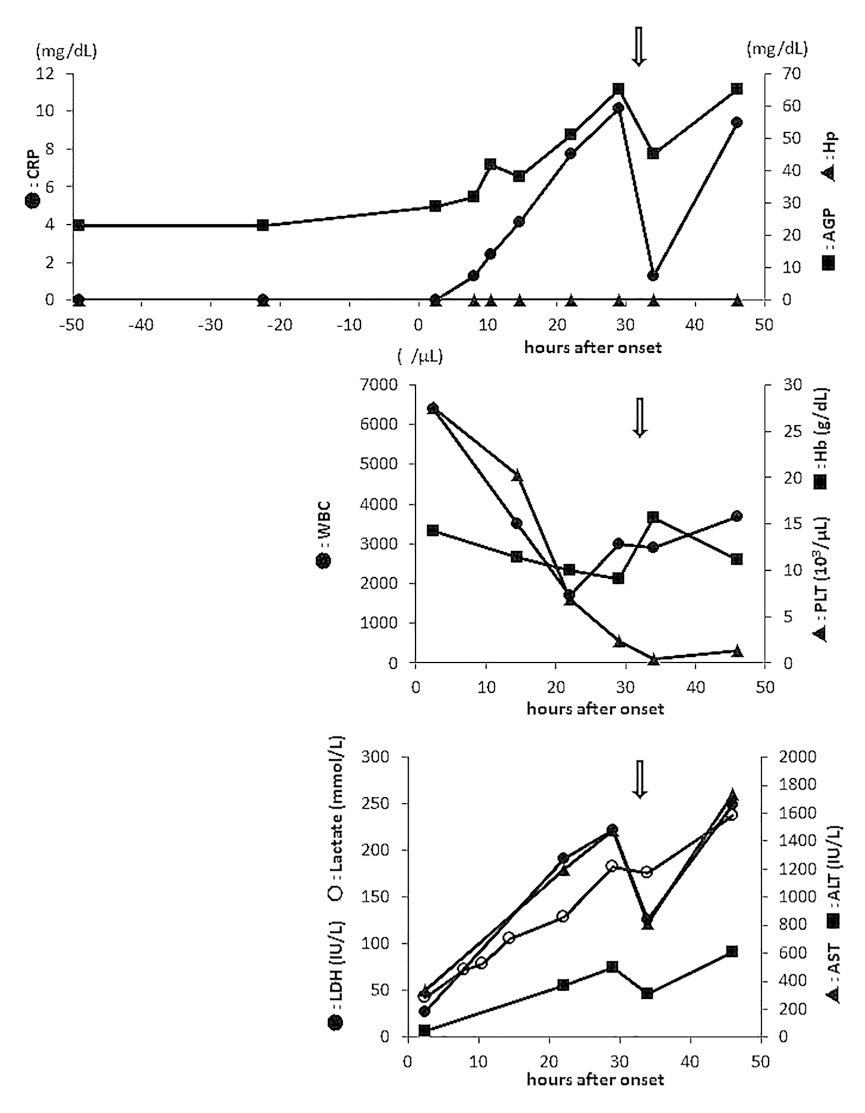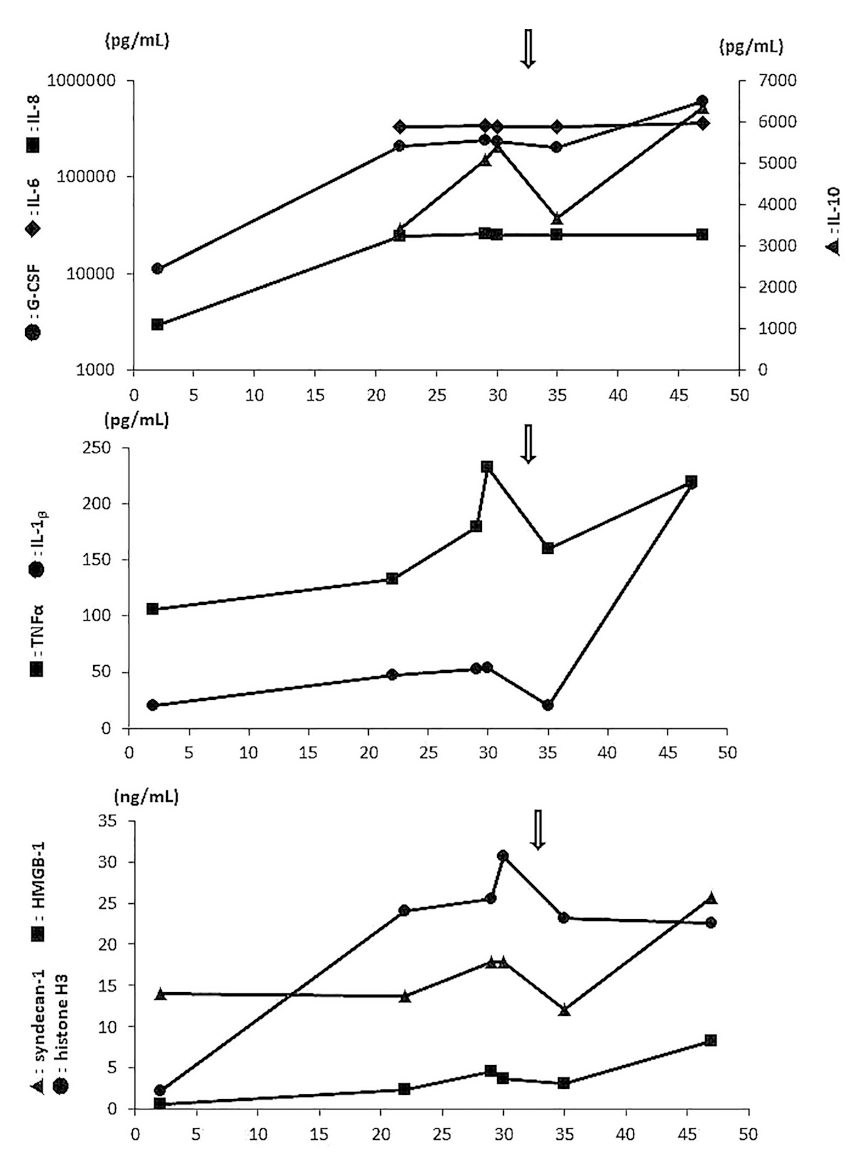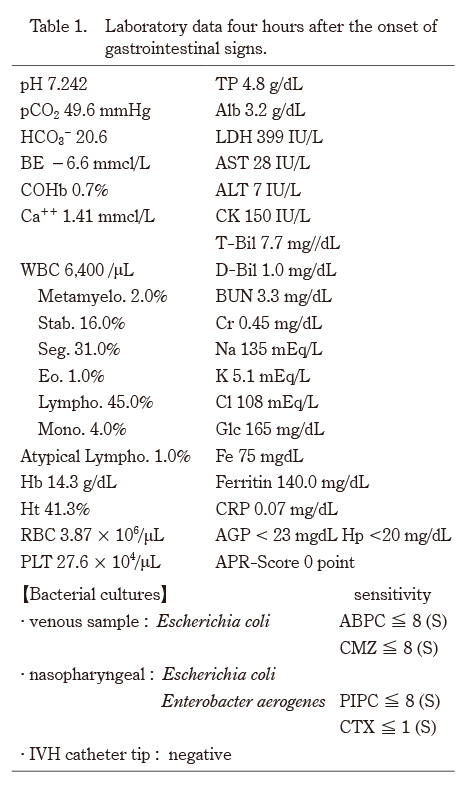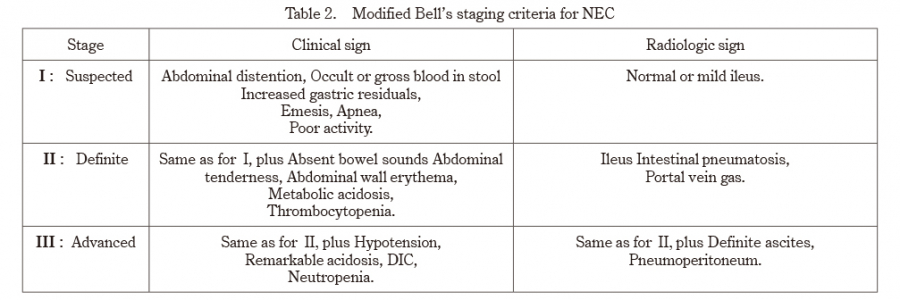We encountered a very rare case of fulminant necrotizing enterocolitis (F-NEC) in a preterm male baby. The course of NEC and sepsis in this case was clearly different from the usual course. After onset at 14 days of life, catheter-related bloodstream infection was first assumed, and antibiotics and γ-globulin administration were started. However, 12 hours after onset, the baby’s abdominal distension increased remarkably, and his entire abdominal wall turned red to purple. Escherichia coli were isolated from the blood culture, but the catheter tip culture was negative. Exchange transfusion was performed 32 hours after onset, but no significant changes were observed in the baby’s general condition, and he died 46 hours after onset. The acute phase reactants of CRP and α1-acid glycoprotein increased, but haptoglobin did not. Although IL-1β and TNFα increased as expected with sepsis, IL-6, IL-8, IL-10, and G-CSF however increased to a greater extent than expected. From the above, we diagnosed the development of intestinal necrosis as a result of widespread intestinal ischemia, and that sepsis was associated with this poor condition.
Abstract/References
Investigation of biomarkers in a rare case of fulminant necrotizing enterocolitis in a preterm infant
Toshihiko Nakamura, Shota Inoue, Kana Ito, Eisuke Fukama, Tomoaki Nomura, Daisuke Hatanaka, Michiko Kusakari, Hidehiro Takahashi, Shingo Yamada
-
Toshihiko Nakamura
Department of Neonatology, Japanese Red Cross Musashino Hospital
-
Shota Inoue
Department of Neonatology, Japanese Red Cross Musashino Hospital
Department of Pediatrics, National Defense Medical College -
Kana Ito
Department of Neonatology, Japanese Red Cross Musashino Hospital
Department of Pediatrics, National Defense Medical College -
Eisuke Fukama
Department of Neonatology, Japanese Red Cross Musashino Hospital
-
Tomoaki Nomura
Department of Neonatology, Japanese Red Cross Musashino Hospital
-
Daisuke Hatanaka
Department of Neonatology, Japanese Red Cross Musashino Hospital
-
Michiko Kusakari
Department of Neonatology, Japanese Red Cross Musashino Hospital
-
Hidehiro Takahashi
Department of Neonatology, Japanese Red Cross Musashino Hospital
-
Shingo Yamada
Shino-Test Corporation
Abstract
References
1. Hunter CH, Upperman JS, Ford HR, Camerini V. Understanding the susceptibility of the premature infant to necrotizing enterocolitis (NEC). Pediatr Res, 63:117-123, 2008.
2. Niño DF, Sodhi CP, Hackam DJ. Necrotizing enterocolitis:new insights into pathogenesis and mechanisms. Nat Rev Gastroenterol Hepatol, 13 (10):590-600, 2016.
3. Shirahata A, Shirakawa Y, Murakami C. Diagnosis of DIC in very low birth weight infants. Semin Thromb Hemost, 24:467-471, 1998.
4. Nakamura T, Yamada S, Yoshioka T. Measurement of plasma concentration of high mobility group box 1 (HMGB-1) in early neonates and evaluation off its usefulness. Clin Chim Acta, 413(1-2):237-239, 2011.
5. Ito T, Nakahara M, Masuda Y, et al. Circlulating histone H3 levels are increased in septic mice in a neutrophil-dependent manner:preclinical evaluation of a novel sandwich ELISA for histone H3. J Intens Care, 6:79-85, 2018.
6. Ikeda M, Matsumoto H, Ogura H, et al. Circulating syndecan-1 predicts the development of disseminated intravascular coagulation in patients with sepsis. J Crit Care, 43:48-53, 2018.
7. Nakamura T, Hatanaka D, Yoshioka T, Yamada S, Goto H. Study of the usefulness of APR scores from the viewpoint of proinflammatory cytokines. Dis Markers.
http:///dx.doi.org/10.1155/2015/981981.
8. Beghetti I, Panizza D, Lenzi J, et al. Probiotics for preventing necrotizing enterocolitis in preterm infants:A network meta –analysis. Nutrients, 13:192, 2021.
9. Jilling T, Simon D, Lu J, et al. The roles of bacterial and TLR4 in rat and murine models of necrotizing enterocolitis. J Immunol, 177:3273-3282, 2006.
10. Neu J, Walker A. Necrotizing enterocolitis. N Eng J Med, 364:255-264, 2011.
11. Hackam DJ, Good M, Sodhi CP. Mechanisms of gut barieer failure in the pathogenesis of necotizing enterocolitis:Toll-like receptors throw the switch. Sem Pediatr Surg, 222:76-82, 2013.
12. De Plaen IG. Inflammatory signaling in necrotizing enterocolitis. Clin Perinatol, 40:109-124, 2013.
13. Lambert DK, Christensen RD, Baer VL, et al. Fulminant necrotizing enterocolitis in a multihospital healthcare system. J Perinatol, 32:194-198, 2012.
14. Garg PM, O’Connor A, Ansari MdAY, et al. Hematological predictors of mortality in neonates with fulminant necrotizing enterocolitis. J Perinatol, 41:1110-1121, 2021.
15. Lin L, Xia X, Liu W, et al. Clinical characteristics of neonatal fulminant necrotizing enterocolitis in a tertiary Children’s hospital in the last 10 years. PLoS ONE, 14(11):e0224880, 2019. https://doi.org/10.1371/journal.pone.0224880.
16. Hammond PJ, Flett ME, De La Hunt M. Fulminant necrotizing enterocolitis immediately following change to low birth weight formula feeds. Eur J Pediatr Surg, 18:185-187, 2008.
17. Voss M, Moore SW, van der Merwe I, Pieper C. Fulminating necrotizing enterocolitis: outcome and prognositic factors. Pediatr Surg Int, 13:576-580, 1998.
18. Ramasamy V, Teo H, Rajadurai VS, Chandran S. Atypical presentation of acute fulminant neonatal necrotizing enterocolitis:diagnostic evaluation over plain radiography of abdomen. BMJ Case Pep, 2016. doi:10.116/bcr-2016-2216756.
19. Chishiki M, Go H, Endo K, Ueda NK, Takehara H, Namai Y. Cytokine profiles before and after exchange transfusion in severe late-onset neonatal group B Streptococcus meningitis:A case report. Tohoku J Exp Med, 253:269-273, 2021.
20. Hibbert J, Strunk T, Simmer K, Richmond P, Burgner D, Currie A. Plasma cytokine profiles in very preterm infants with late-onset sepsis. PLoS ONE, 15(5):e0232933, 2020.
https://doi.org/10.1371/journal.pne.0232933.
21. Khaertynov KhS, Boichuk SV, Khaiboullina SF, et al. Comparative assessment of cytokine pattern in early and late onset of neonatal sepsis. J Immunol Res, 2017, 8601063. https://doi.org/10.1155/2017/8601063.
22. Hatanaka K, Ito T, Madokoro Y, et al. Circulating syndecan-1 as a predictor of persistent thrombocytopenia and lethal outcome:A population study of patients with suspected sepsis requiring intensive care. Front Cardiovac Med, 8:730553, 2021. doi:10.3389/fcvm.2021.
23. Hatada T, Wada H, Nobori T, et al. Plasma concentrations and importance of high mobility group box protein in the prognosis of organ failure in patients with disseminated intravascular coagulation. Thromb Haemost, 94:975-979, 2005.
24. Benkoe T, Baumann S, Weninger M, et al. Comprehensive evaluation of 11 cytokines in premature infants with surgical necrotizing enterocolitis. PLos ONE, 8(3):e58720, 2013. https://doi.org/10.1371/journal.pne.0058720.
25. Maheshwari A, Schelonka RL, Dimmitt RA, et al. Cytokines associated with necrotizing enterocolitis in extremely-low-birth-weight infants. Peditatr Res, 76(1):100-108, 2014. doi:10.1038/pr.2014.48.
26. Bhatia AM, Stoll BJ, Cismowski MJ, Hamrick SE. Cytokine levels in the preterm infant with neonatal intestinal injury. Am J Perinatol, 31 (6):489-496, 2014. doi:10.1055/s-0033-1353437.
27. Cho SX, Berger PJ, Nold-Petry CA, Nols MF. The immunological landscape in necrotizing enterocolitis. Exp Rev Mol Med, 18:e12, 2016. doi:10.1017/erm.2016.13.
28. Orrock JE, Panchapakesan K, Vezina G, et al. Association of brain injury and neonatal cytokine response during therapeutic hypothermia in newborns with hypoxic-ischemic encephalopathy. Pediatr Res, 79(5):742-747, 2016.
29. Okazaki K, Nishida A, Kato M, Kozawa K, Uga N, Kimura H. Elevation of cytokine concentrations in asphyxiated neonates. Biol Neonate, 89(3):183-189, 2006.
30. Roka A, Bek G, Halasz J, et al. Changes in serum cytokine and cortisol levels inn normothermic and hypothermic term neonates after perinatal asphyxia. Inflamm Res, 62:81-87, 2013.
Figures
